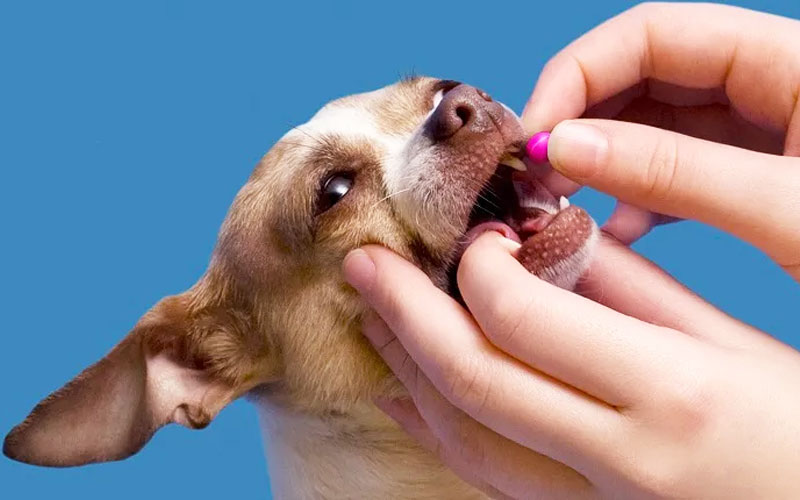
Benadryl, a brand name for diphenhydramine, is a popular antihistamine that treats dogs’ allergies, motion sickness, and nervousness. Dogs can safely take Benadryl if given as directed, but knowing the correct dosage and other factors is essential.
This article explains how much Benadryl to give a 50-pound dog, assuring your pet’s safety and well-being. So, let’s get right into our article.
Understanding Benadryl and Its Uses
Benadryl prevents the body’s histamine production, which is responsible for allergic reactions. It is used to treat many different canine ailments, such as:
- Allergic reactions: Seasonal allergies, insect stings, and food allergies.
- Motion sickness: To avoid feeling queasy or throwing up when driving.
- Anxiety: Nervous dogs might benefit from mild sedatives.
- Insomnia: Because of its calming qualities, insomnia helps dogs with difficulty falling asleep.
Correct Dosage of Benadryl for a 50 lb Dog

Benadryl comes in several forms, including liquid, pills, and creams. However, only the oral versions are appropriate for dogs.
The standard Benadryl dosage for dogs is 1mg per pound of body weight, administered twice to three times each day. In terms of a 50-pound dog, this equals;
1. Tablets
- Benadryl tablets are commonly available in 25 mg dosages.
- A 50-pound dog would be given two 25-milligram tablets.
2. Liquid
- Giving the medication in liquid form is frequently easier, particularly for small dogs or those with trouble swallowing tablets.
- Children’s Benadryl liquid usually contains 12.5 mg of diphenhydramine per 5 ml (1 teaspoon).
- The dosage for a 50 lb dog would be 20 ml, which is around 4 tablespoons.
- You have to make sure the liquid form does not include alcohol.
How to Feed Benadryl to Your Dog Without Knowing Them?
Check out some tips to help you give the medication to your dog without knowing them.
- If you are giving Benadryl in tablet form, you can hide the pill in their favorite food and feed them.
- You can also use pill pockets with a hollow center designed to hold pills inside. You can put the tablet inside it and feed your dog.
- Another best tip is crushing the medication pill into a fine powder and mixing it with your dog’s wet food.
- If you’re giving the medication in a liquid form, you can dissolve it in a small amount of broth and feed it.
- Last but not least, one of the best tips is to praise and reward your dog with its favorite treat after it takes its medication.
What are the Various Safety Precautions and Considerations Before Giving Benadryl to Your Dog?
Here are some safety precautions and considerations before giving Benadryl to your furry friend.
1. Speak with Your Veterinarian
Before administering Benadryl to your dog, make sure to consult your dog’s veterinarian. They can provide specific dosage recommendations based on your dog’s size, weight, and health condition.
If you don’t have enough knowledge and you’re still giving the medication on your own, it can lead to incorrect dosages or adverse reactions.
2. Side Effects
It is essential to be familiar with Benadryl’s side effects before medicating your furry friend with it. Benadryl can cause various side effects, such as drowsiness, dry mouth, urinary retention, and gastrointestinal issues like diarrhea or vomiting.
You must be aware of these side effects. Monitor your dog’s reaction and seek veterinary advice if any severe or concerning symptoms arise.
3. Avoid Certain Formulations
Benadryl comes in various formulations, including tablets, capsules, and liquid. Therefore, it’s essential to use the correct formulation for your dog. You must avoid those with added ingredients like artificial sweeteners (xylitol), which are toxic to dogs.
You can even call the veterinarian, who will recommend the safest and most effective formulation for your pet.
4. Monitor For Overdose
Signs of Benadryl overdose in dogs include extreme drowsiness, agitation, rapid heart rate, difficulty breathing, or seizures.
If you suspect any overdose side effects in your dog, you have to consult the veterinarian immediately. Also, you have to make sure to keep the medication out of reach of your dog to prevent accidental overdosing in the future.
5. Check for Allergies
You have to make sure your dog is not allergic to Benadryl or any of its ingredients. An allergic reaction to the medication can cause symptoms like itching, swelling, difficulty breathing, or anaphylaxis.
Therefore, make sure to monitor your dog after the dosage to identify any adverse reactions promptly.
6. Consider Past Health Conditions
If your dog is suffering from certain health conditions, such as glaucoma, high blood pressure, cardiovascular disease, or urinary retention, it may not be suitable to feed them Benadryl.
You can consult the doctor to determine whether your dog is already suffering from any health conditions that could become more harmful after the medication.
Some Natural Alternatives to Benadryl for Your Dog
- Quercetin: Often referred to as “nature’s Benadryl,” Quercetin is a natural antihistamine and anti-inflammatory found in many fruits and vegetables. It can help reduce allergy symptoms and is available in supplement form.
- Chamomile: Chamomile has calming properties that can help reduce anxiety and soothe irritated skin. You can prepare chamomile tea, let it cool, and then add it to your dog’s food or water.
- Apis Mellifica: Apis Mellifica, derived from honeybees, is used in homeopathy to treat swelling and allergic reactions.
- Lavender Oil: Lavender oil has calming properties and can help reduce anxiety and itchiness. You can dilute a few drops and apply it to your dog’s skin.
Wrapping Up
A 50-pound dog’s dosage of Benadryl must be carefully monitored, and any adverse effects must be carefully noted. The suggested dose is 50 milligrams, given 2-3 times daily. For the greatest care for your pet, always use the recommended formulation, stay away from dangerous additives, and speak with your veterinarian. By following these instructions, you may safely treat your dog’s symptoms and enhance its quality of life.







